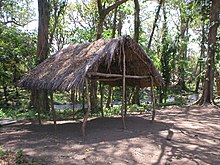

A post in ground construction, also called earthfast[1] or hole-set posts, is a type of construction in which vertical, roof-bearing timbers, called posts, are in direct contact with the ground. They may be placed into excavated postholes,[2] driven into the ground, or on sills which are set on the ground without a foundation. Earthfast construction is common from the Neolithic period to the present and is used worldwide. Post-in-the-ground construction is sometimes called an "impermanent" form, used for houses which are expected to last a decade or two before a better quality structure can be built.[3]
Post in ground construction can also include sill on grade, wood-lined cellars, and pit houses. Most pre-historic and medieval wooden dwellings worldwide were built post in ground.
- ^ Oxford English Dictionary Second Edition on CD-ROM (v. 4.0). Oxford University Press, 2009
- ^ "Home". stavkirke.org.
- ^ Carson, Cary, Norman F. Barka, William M. Kelso, Garry Wheller Stone, and Dell Upton. "Impermanent Architecture in the Southern American Colonies." Material Life in America, 1600-1860, edited by Robert Blair St. George, 113-158. Boston: Northern University Press, 1988.
